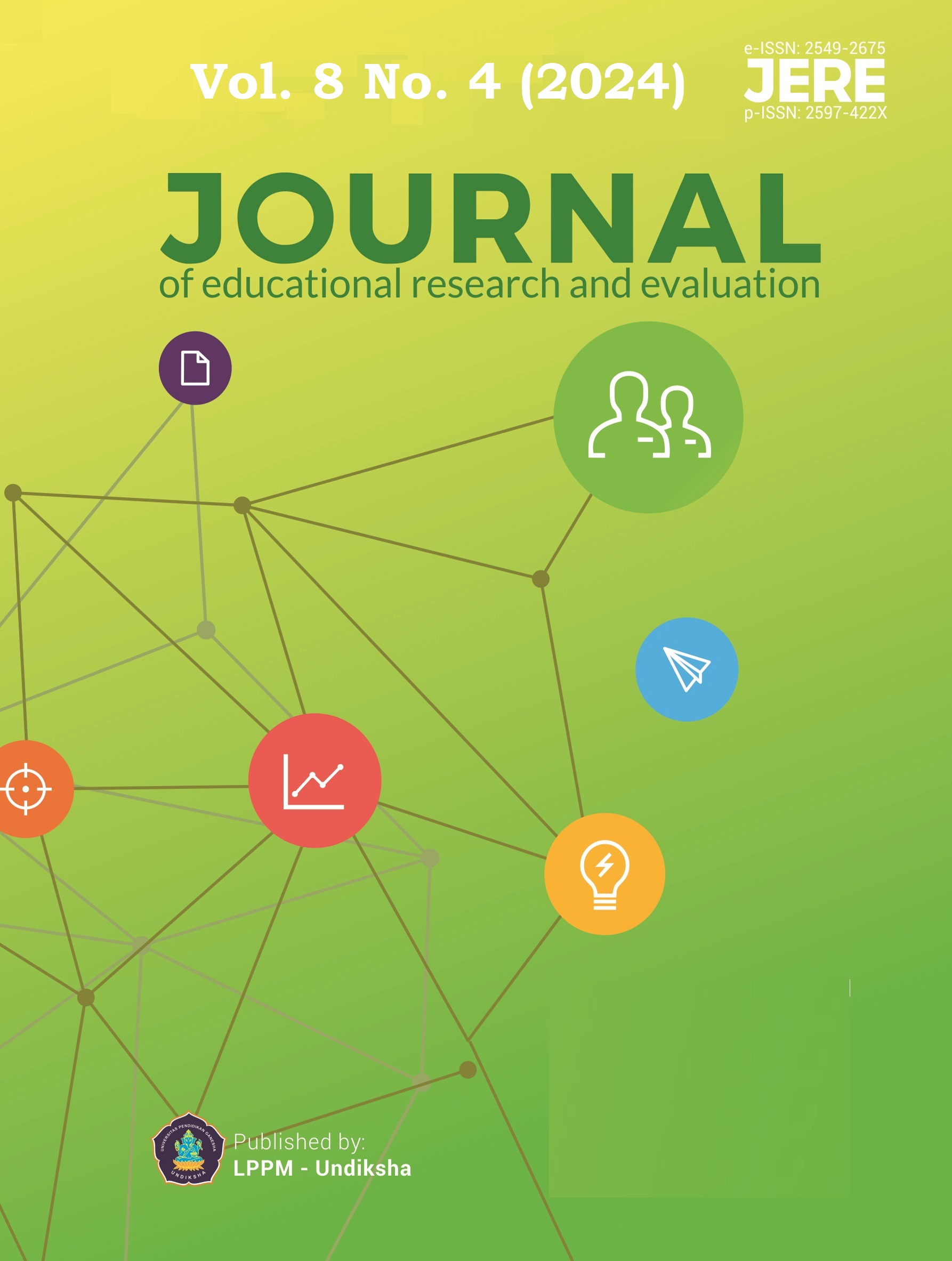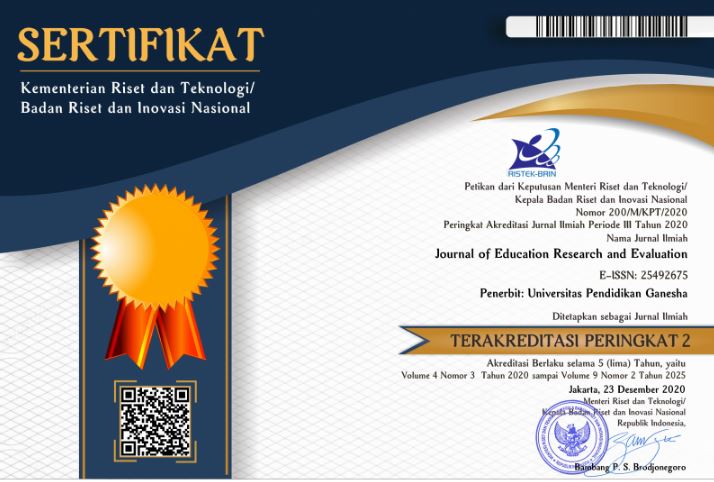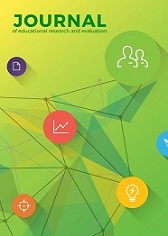Significant Relationship Between Family Conflict and the Implications of Students Who Are Frequently Bullied at School
DOI:
https://doi.org/10.23887/jere.v8i4.77183Kata Kunci:
Student Bullying Treatment, Exit Conflict, Student Bullying TendenciesAbstrak
Bullying is a problem that often occurs in schools. Facts show that students who often carry out bullying come from less harmonious family backgrounds. This is urgent to research with the aim of analyzing the relationship between family conflict and the stages of bullying in male students in middle school. Quantitative research method. The subjects were students with a population of 450 people and only 76 students had bullying tendencies. These 76 students were selected as samples in this study. Data collection techniques using instruments. Question instrument to investigate the Bullying Behavior Stage. Family Conflict Violence Investigation is used to measure students' stages of family conflict. Measurement with a Likert scale of 1-5. Descriptive statistical analysis techniques and inference statistics (Pearson correlation test). The results and findings show that the level of bullying among male students tends to be at a low level (2.52). A significant relationship was found between family conflict and stages of bullying. It was found that the frequency of conflict was minimal for the type of sibling conflict within students at school and the most frequent conflict was between parents and students. The findings show that family conflict factors need to receive serious attention and be taken into account in designing intervention programs to prevent the bullying phenomenon from becoming more serious in schools.
Referensi
Agyeman, S., & Cheng, L. (2020). Analysis of barriers to perceived service quality in Ghana: Students’ perspectives on bus mobility attributes. Transport Policy, 99(May), 63–85. https://doi.org/10.1016/j.tranpol.2020.08.015.
Arias-Rivera, S., & García, V. H. (2020). Theoretical framework and explanatory factors for child-to-parent violence. A scoping review. Anales de Psicologia, 36(2), 220–231. https://doi.org/10.6018/analesps.338881.
Baas, J., Schotten, M., Plume, A., Côté, G., & Karimi, R. (2020). Scopus as a curated, high-quality bibliometric data source for academic research in quantitative science studies. Quantitative Science Studies, 1(1), 377–386. https://doi.org/10.1162/qss_a_00019.
Baiden, P., LaBrenz, C. A., Okine, L., Thrasher, S., & Asiedua-Baiden, G. (2020). The toxic duo: Bullying involvement and adverse childhood experiences as factors associated with school disengagement among children. Children and Youth Services Review, 119(December 2020), 105383.1-52. https://doi.org/10.1016/j.childyouth.2020.105383.
Baiden, P., & Tadeo, S. K. (2020). Investigating the association between bullying victimization and suicidal ideation among adolescents: Evidence from the 2017 Youth Risk Behavior Survey. Child Abuse and Neglect, 102(May 2019), 104417.1-12. https://doi.org/10.1016/j.chiabu.2020.104417.
Bi, X., & Marsden, E. (2020). Managing interpersonal relationships: Teasing as a method of professional identity construction. Journal of Pragmatics, 165(August 2020), 18–30. https://doi.org/10.1016/j.pragma.2020.05.003.
Boccio, C. M., Leal, W. E., & Jackson, D. B. (2022). Bullying victimization and nicotine and marijuana vaping among Florida adolescents. Drug and Alcohol Dependence, 237(December 2021), 109536.1-7. https://doi.org/10.1016/j.drugalcdep.2022.109536.
Brophy, K., Brähler, E., Hinz, A., Schmidt, S., & Körner, A. (2020). The role of self-compassion in the relationship between attachment, depression, and quality of life. Journal of Affective Disorders, 260(June 2019), 45–52. https://doi.org/10.1016/j.jad.2019.08.066.
Cáceres, I., Moreno, C., Román, M., & Palacios, J. (2021). The social competence of internationally-adopted and institutionalized children throughout childhood: a comparative and longitudinal study. Early Childhood Research Quarterly, 57(4th Quarter 2021), 260–270. https://doi.org/10.1016/j.ecresq.2021.07.002.
Chi, X., Hong, X., & Chen, X. (2020). Profiles and sociodemographic correlates of Internet addiction in early adolescents in southern China. Addictive Behaviors, 106(October 2019), 106385.1-7. https://doi.org/10.1016/j.addbeh.2020.106385.
Chu, M., Fang, Z., Mao, L., Ma, H., Lee, C. Y., & Chiang, Y. C. (2024). Creating A child-friendly social environment for fewer conduct problems and more prosocial behaviors among children: A LASSO regression approach. Acta Psychologica, 244(February), 104200.1-16. https://doi.org/10.1016/j.actpsy.2024.104200.
Chung, J. Y., & Lee, S. (2020). Are bully-victims homogeneous? Latent class analysis on school bullying. Children and Youth Services Review, 112(January), 104922.1-7. https://doi.org/10.1016/j.childyouth.2020.104922.
Craig, W., Boniel-Nissim, M., King, N., Walsh, S. D., Boer, M., Donnelly, P. D., Harel-Fisch, Y., Malinowska-Cieślik, M., Gaspar de Matos, M., Cosma, A., Van den Eijnden, R., Vieno, A., Elgar, F. J., Molcho, M., Bjereld, Y., & Pickett, W. (2020). Social Media Use and Cyber-Bullying: A Cross-National Analysis of Young People in 42 Countries. Journal of Adolescent Health, 66(6), S100–S108. https://doi.org/10.1016/j.jadohealth.2020.03.006.
Dennehy, R., Meaney, S., Walsh, K. A., Sinnott, C., Cronin, M., & Arensman, E. (2020a). Young people’s conceptualizations of the nature of cyberbullying: A systematic review and synthesis of qualitative research. Aggression and Violent Behavior, 51(January 2020), 101379.1-12. https://doi.org/10.1016/j.avb.2020.101379.
Dennehy, R., Meaney, S., Walsh, K. A., Sinnott, C., Cronin, M., & Arensman, E. (2020b). Young people’s conceptualizations of the nature of cyberbullying: A systematic review and synthesis of qualitative research. Aggression and Violent Behavior, 51(January 2019), 101379.1-12. https://doi.org/10.1016/j.avb.2020.101379.
Duan, S., Duan, Z., Li, R., Wilson, A., Wang, Y., Jia, Q., Yang, Y., Xia, M., Wang, G., Jin, T., Wang, S., & Chen, R. (2020). Bullying victimization, bullying witnessing, bullying perpetration and suicide risk among adolescents: A serial mediation analysis. Journal of Affective Disorders, 273(March 2020), 274–279. https://doi.org/10.1016/j.jad.2020.03.143.
Ed, M., & Ed, D. (2020). Psychology and Law: Research for practice. In Psychology and Law: Research for practice. https://doi.org/10.2478/9788395669682.
Espejo-Siles, R., Zych, I., Farrington, D. P., & Llorent, V. J. (2020). Moral disengagement, victimization, empathy, social and emotional competencies as predictors of violence in children and adolescents. Children and Youth Services Review, 118(May), 105337.1-8. https://doi.org/10.1016/j.childyouth.2020.105337.
Estévez, E., Cañas, E., Estévez, J. F., & Povedano, A. (2020). Continuity and overlap of roles in victims and aggressors of bullying and cyberbullying in adolescence: a systematic review. International Journal of Environmental Research and Public Health, 17(20), 1–15. https://doi.org/10.3390/ijerph17207452.
Garcia-Carrion, R., Villarejo, B. C., & Villardón-Gallego, L. (2019). Children and adolescents mental health: A systematic review of interaction-based interventions in schools and communities. Frontiers in Psychology, 10(APR), 1–10. https://doi.org/10.3389/fpsyg.2019.00918.
Garner, P. W., Dunsmore, J. C., & Bassett, H. H. (2020). Direct and indirect pathways to early school adjustment: Roles of young children’s mental representations and peer victimization. Early Childhood Research Quarterly, 51(2nd Quarter 2020), 100–109. https://doi.org/10.1016/j.ecresq.2019.09.001.
Gatti, M., Palumbo, R., Di Domenico, A., & Mammarella, N. (2022). Affective health and countermeasures in long-duration space exploration. Heliyon, 8(5), e09414.1-11. https://doi.org/10.1016/j.heliyon.2022.e09414.
Hestermann, N., Le Yaouanq, Y., & Treich, N. (2020). An economic model of the meat paradox. European Economic Review, 129(October 2020), 103569.1-16. https://doi.org/10.1016/j.euroecorev.2020.103569.
Hu, Y., & Liu, L. (2020). Becoming industrious female citizens: Work, discipline, and negotiation in Chinese female prison. International Journal of Law, Crime and Justice, 63(December 2020), 100420.1-9. https://doi.org/10.1016/j.ijlcj.2020.100420.
Huang, C. L., Zhang, S., & Yang, S. C. (2020). How students react to different cyberbullying events: Past experience, judgment, perceived seriousness, helping behavior and the effect of online disinhibition. Computers in Human Behavior, 110(March), 106338.1-8. https://doi.org/10.1016/j.chb.2020.106338.
Islam, M. I., Khanam, R., & Kabir, E. (2020). Bullying victimization, mental disorders, suicidality and self-harm among Australian high schoolchildren: Evidence from nationwide data. Psychiatry Research, 292(July 2020), 113364.1-9. https://doi.org/10.1016/j.psychres.2020.113364.
Kalu, S. R., Menon, S. E., & Quinn, C. R. (2020). The relationship between externalizing behavior and school and familial attachments among girls from diverse backgrounds. Children and Youth Services Review, 116(September 2020), 105170.1-56. https://doi.org/10.1016/j.childyouth.2020.105170.
Karatuna, I., Jönsson, S., & Muhonen, T. (2020). Workplace bullying in the nursing profession: A cross-cultural scoping review. International Journal of Nursing Studies, 111(November 2020), 1-9. https://doi.org/10.1016/j.ijnurstu.2020.103628.
Karcher, N. R., Niendam, T. A., & Barch, D. M. (2020). Adverse childhood experiences and psychotic-like experiences are associated above and beyond shared correlates: Findings from the adolescent brain cognitive development study. Schizophrenia Research, 222(August 2020), 235–242. https://doi.org/10.1016/j.schres.2020.05.045.
Kerr, R., & Kerr, G. (2020). Promoting athlete welfare: A proposal for an international surveillance system. Sport Management Review, 23(1), 95–103. https://doi.org/10.1016/j.smr.2019.05.005.
Khoury-Kassabri, M., Zadok, I., Eseed, R., & T. Alexander, V. (2020). Individual and familial factors as mediators and moderators of young children’s aggressive behavior. Children and Youth Services Review, 118(May 2020.), 105428.1-9. https://doi.org/10.1016/j.childyouth.2020.105428.
Kircaburun, K., Harris, A., Calado, F., & Griffiths, M. D. (2021). The Psychology of Mukbang Watching: A Scoping Review of the Academic and Non-academic Literature. International Journal of Mental Health and Addiction, 19(4), 1190–1213. https://doi.org/10.1007/s11469-019-00211-0.
Kisfalusi, D., Pál, J., & Boda, Z. (2020). Bullying and victimization among majority and minority students: The role of peers’ ethnic perceptions. Social Networks, 60(January 2020), 48–60. https://doi.org/10.1016/j.socnet.2018.08.006.
Kızıltepe, R., Irmak, T. Y., Eslek, D., & Hecker, T. (2020a). Prevalence of violence by teachers and its association to students’ emotional and behavioral problems and school performance: Findings from secondary school students and teachers in Turkey. Child Abuse and Neglect, 107(January 2020), 1-12. https://doi.org/10.1016/j.chiabu.2020.104559.
Kızıltepe, R., Irmak, T. Y., Eslek, D., & Hecker, T. (2020b). Prevalence of violence by teachers and its association to students’ emotional and behavioral problems and school performance: Findings from secondary school students and teachers in Turkey. Child Abuse and Neglect, 107(May), 1-12. https://doi.org/10.1016/j.chiabu.2020.104559.
Lee, M. H., Lee, G. A., Lee, S. H., & Park, Y. H. (2019). Effectiveness and core components of infection prevention and control programmes in long-term care facilities: a systematic review. Journal of Hospital Infection, 102(4), 377–393. https://doi.org/10.1016/j.jhin.2019.02.008.
Lee, M. Y., Wang, H. S., & Chen, C. J. (2020). Development and Validation of the Social Adjustment Scale for Adolescents with Tourette Syndrome in Taiwan. Journal of Pediatric Nursing, 51(March–April 2020), e13–e20. https://doi.org/10.1016/j.pedn.2019.05.023.
Li, M. H., Whitehead, M., Green, N., Ren, H., Cheng, C. F., Lin, L. L. C., Lin, C. P., Liu, Y., Wen, X., Lei, S. M., Li, H., Shy, D. Y., Tang, Y., Choi, S. M., Huang, Y., Ma, R., Wang, F. J., Chen, S., & Sum, R. K. W. (2022). Operationally defining physical literacy in Chinese culture: Results of a meta-narrative synthesis and the Panel’s recommendations. Journal of Exercise Science and Fitness, 20(3), 236–248. https://doi.org/10.1016/j.jesf.2022.04.003.
Liew, T. W., Tan, S. M., Yoo, N. E., Gan, C. L., & Lee, Y. Y. (2023). Let’s talk about Sex!: AI and relational factors in the adoption of a chatbot conveying sexual and reproductive health information. Computers in Human Behavior Reports, 11(June 2023), 100323.1-15. https://doi.org/10.1016/j.chbr.2023.100323.
López, V., García-Quiroga, M., Benbenishty, R., González, L., Squicciarini, A. M., & Sánchez, P. (2020). Sexual harassment by peers in Chilean schools. Child Abuse and Neglect, 107(June), 104602.1-12. https://doi.org/10.1016/j.chiabu.2020.104602.
Miseliunaite, B., Kliziene, I., & Cibulskas, G. (2022). Can Holistic Education Solve the World’s Problems: A Systematic Literature Review. Sustainability (Switzerland), 14(15), 1-22. https://doi.org/10.3390/su14159737.
Mishna, F., Sanders, J. E., McNeil, S., Fearing, G., & Kalenteridis, K. (2020). “If Somebody is Different”: A critical analysis of parent, teacher and student perspectives on bullying and cyberbullying. Children and Youth Services Review, 118(April), 105366.1-13. https://doi.org/10.1016/j.childyouth.2020.105366.
Neavins, T. M., Murphy, C. M., Yiaslas, T. A., & Demorest, M. E. (2020). Daily and situational reports of substance use and dating violence among college students: A 10-week prospective study. Addictive Behaviors Reports, 12(October 2020), 100309.1-9. https://doi.org/10.1016/j.abrep.2020.100309.
O’Brien, B. A., Ng, S. C., & Arshad, N. A. (2020). The structure of home literacy environment and its relation to emergent English literacy skills in the multilingual context of Singapore. Early Childhood Research Quarterly, 53(4th Quarter 2020), 441–452. https://doi.org/10.1016/j.ecresq.2020.05.014.
Paez, G. R. (2020). School safety agents’ identification of adolescent bullying. Children and Youth Services Review, 113(March), 104942.1-9. https://doi.org/10.1016/j.childyouth.2020.104942.
Pereda, N., & Díaz-Faes, D. A. (2020). Family violence against children in the wake of COVID-19 pandemic: a review of current perspectives and risk factors. Child and Adolescent Psychiatry and Mental Health, 14(1), 1–7. https://doi.org/10.1186/s13034-020-00347-1.
Pichel, R., Feijóo, S., Isorna, M., Varela, J., & Rial, A. (2022). Analysis of the relationship between school bullying, cyberbullying, and substance use. Children and Youth Services Review, 134(May 2021), 1-8. https://doi.org/10.1016/j.childyouth.2022.106369.
Qin, Y., Hong, K., Chen, J., & Zhang, Z. (2020). Asymmetric effects of geopolitical risks on energy returns and volatility under different market conditions. Energy Economics, 90(August 2020), 104851.1-10. https://doi.org/10.1016/j.eneco.2020.104851.
Schoville, R., & Aebersold, M. (2020). How Workplace Bullying and Incivility Impacts Patient Safety: A Qualitative Simulation Study Using BSN Students. Clinical Simulation in Nursing, 45(August 2020), 16–23. https://doi.org/10.1016/j.ecns.2020.01.003.
Sesen, H., & Ekemen, M. A. (2020). Data on personal and contextual factors of university students on their entrepreneurial intentions in some Turkish universities. Data in Brief, 28(February 2020), 105086.1-5. https://doi.org/10.1016/j.dib.2019.105086.
Taylor, J., Murray, R., Binzer, M., Robert Borse, C., Davis, A., Gallogly, V., Ghanbari, R., Diane McKinsey, L., Chief David Picone, B., & Gary Wingrove, P. (2023). EMERG-ing data: Multi-city surveillance of workplace violence against EMS responders. Journal of Safety Research, 86, 62–79. https://doi.org/10.1016/j.jsr.2023.06.008.
Tristão, S. K. P. C., Magno, M. B., Pintor, A. V. B., Christovam, I. F. O., Ferreira, D. M. T. P., Maia, L. C., & de Souza, I. P. R. (2020). Is there a relationship between malocclusion and bullying? A systematic review. Progress in Orthodontics, 21(1), 1-22. https://doi.org/10.1186/s40510-020-00323-7.
Urano, Y., Takizawa, R., Ohka, M., Yamasaki, H., & Shimoyama, H. (2020). Cyber bullying victimization and adolescent mental health: The differential moderating effects of intrapersonal and interpersonal emotional competence. Journal of Adolescence, 80(January 2020.), 182–191. https://doi.org/10.1016/j.adolescence.2020.02.009.
Waddell, C., Van Doorn, G., March, E., & Grieve, R. (2020). Dominance or deceit: The role of the Dark Triad and hegemonic masculinity in emotional manipulation. Personality and Individual Differences, 166(November 2019), 110160.1-6. https://doi.org/10.1016/j.paid.2020.110160.
Willan, S., Gibbs, A., Shai, N., Ntini, N., Petersen, I., & Jewkes, R. (2020). Did young women in South African informal settlements display increased agency after participating in the Stepping Stones and Creating Futures intervention? A qualitative evaluation. Social Science and Medicine, 265(November 2020), 113302.1-10. https://doi.org/10.1016/j.socscimed.2020.113302.
Wu, C. Y., & Lee, T. S. H. (2020). Impact of parent–child relationship and sex on trajectories of children internalizing symptoms. Journal of Affective Disorders, 260(September 2019), 167–173. https://doi.org/10.1016/j.jad.2019.09.016.
Xiang, L. (2020). Energy emergency supply chain collaboration optimization with group consensus through reinforcement learning considering non-cooperative behaviours. Energy, 210(November 2020), 118597.1-14. https://doi.org/10.1016/j.energy.2020.118597.
Xu, M., Macrynikola, N., Waseem, M., & Miranda, R. (2020). Racial and ethnic differences in bullying: Review and implications for intervention. Aggression and Violent Behavior, 50(January–February 2020), 101340.1-90. https://doi.org/10.1016/j.avb.2019.101340.
Zeynel, Z., & Uzer, T. (2020). Adverse childhood experiences lead to trans-generational transmission of early maladaptive schemas. Child Abuse and Neglect, 99(July 2019), 104235.1-14. https://doi.org/10.1016/j.chiabu.2019.104235.
Zhang, C., Xu, W., & Lu, H. (2020). Longitudinal relationship between inferiority and aggression in Chinese college students: The moderation of left-behind experience. Personality and Individual Differences, 156(August 2019), 109791.1-6. https://doi.org/10.1016/j.paid.2019.109791.
Zhang, Q., Cao, Y., Tian, J. J., El-Lim, K., & Gentile, D. A. (2020). Effects of prosocial cartoon models on aggressive cognitions and aggressive behaviors. Children and Youth Services Review, 118(November 2020), 105498.1-48. https://doi.org/10.1016/j.childyouth.2020.105498.
Zhao, W., Zhang, J., Liu, X., & Jiang, Z. (2022). Application of ISO 26000 in digital education during COVID-19. Ain Shams Engineering Journal, 13(3), 101630.1-10. https://doi.org/10.1016/j.asej.2021.10.025.
Zhou, Z., Zhou, X., Shen, G., Khairani, A. Z., & Saibon, J. (2023). Correlates of Bullying Behavior Among Children and Adolescents in Physical Education: A Systematic Review. Psychology Research and Behavior Management, 16, 5041–5051. https://doi.org/10.2147/PRBM.S441619.
Zhu, W., Chen, Y., & Xia, L. X. (2020). Childhood maltreatment and aggression: The mediating roles of hostile attribution bias and anger rumination. Personality and Individual Differences, 162(September 2019), 110007.1-7. https://doi.org/10.1016/j.paid.2020.110007.
Unduhan
Diterbitkan
Cara Mengutip
Terbitan
Bagian
Lisensi
Hak Cipta (c) 2024 Mutia Qana'a

Artikel ini berlisensiCreative Commons Attribution-ShareAlike 4.0 International License.
Authors who publish with the Journal of Evaluation and Research in Education (JERE) agree to the following terms:
- Authors retain copyright and grant the journal the right of first publication with the work simultaneously licensed under a Creative Commons Attribution License (CC BY-SA 4.0) that allows others to share the work with an acknowledgment of the work's authorship and initial publication in this journal.
- Authors are able to enter into separate, additional contractual arrangements for the non-exclusive distribution of the journal's published version of the work (e.g., post it to an institutional repository or publish it in a book), with an acknowledgment of its initial publication in this journal.
- Authors are permitted and encouraged to post their work online (e.g., in institutional repositories or on their website) prior to and during the submission process, as it can lead to productive exchanges, as well as earlier and greater citation of published work. (See The Effect of Open Access)











